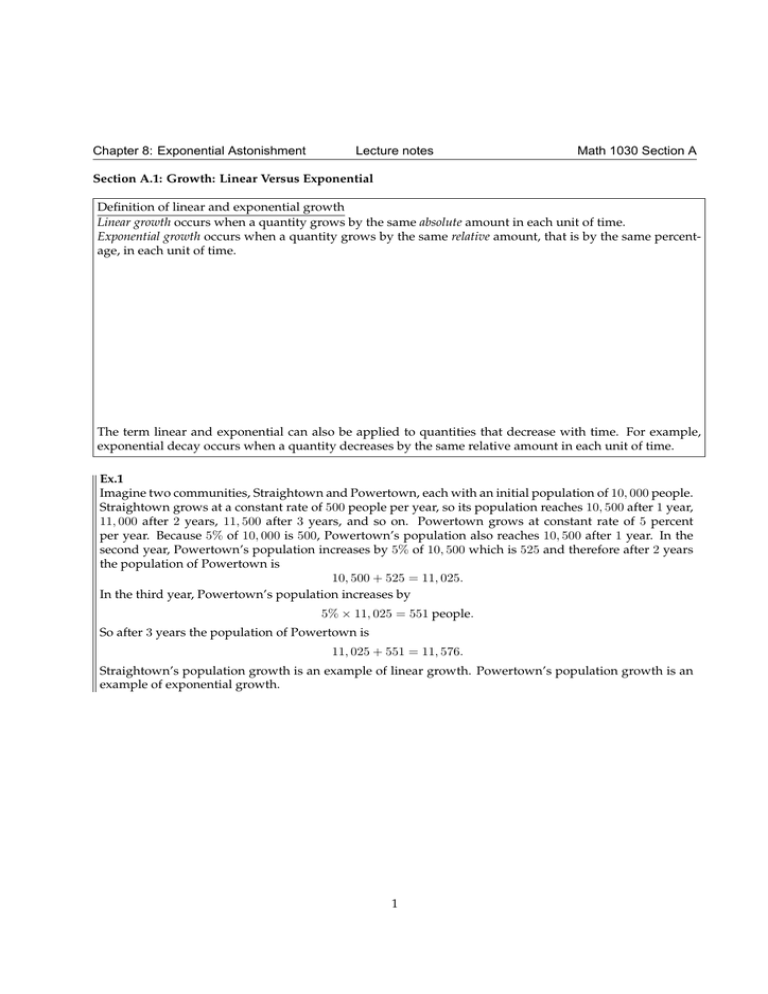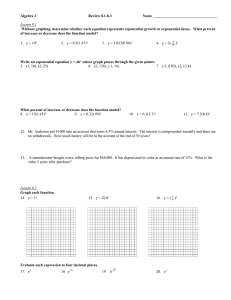Chapter 8: Exponential Astonishment Lecture notes Math 1030 Section A
advertisement

Chapter 8: Exponential Astonishment Lecture notes Math 1030 Section A Section A.1: Growth: Linear Versus Exponential Definition of linear and exponential growth Linear growth occurs when a quantity grows by the same absolute amount in each unit of time. Exponential growth occurs when a quantity grows by the same relative amount, that is by the same percentage, in each unit of time. The term linear and exponential can also be applied to quantities that decrease with time. For example, exponential decay occurs when a quantity decreases by the same relative amount in each unit of time. Ex.1 Imagine two communities, Straightown and Powertown, each with an initial population of 10, 000 people. Straightown grows at a constant rate of 500 people per year, so its population reaches 10, 500 after 1 year, 11, 000 after 2 years, 11, 500 after 3 years, and so on. Powertown grows at constant rate of 5 percent per year. Because 5% of 10, 000 is 500, Powertown’s population also reaches 10, 500 after 1 year. In the second year, Powertown’s population increases by 5% of 10, 500 which is 525 and therefore after 2 years the population of Powertown is 10, 500 + 525 = 11, 025. In the third year, Powertown’s population increases by 5% × 11, 025 = 551 people. So after 3 years the population of Powertown is 11, 025 + 551 = 11, 576. Straightown’s population growth is an example of linear growth. Powertown’s population growth is an example of exponential growth. 1 Chapter 8: Exponential Astonishment Lecture notes Math 1030 Section A Ex.2 In each of the following situations, state weather the growth (or decay) is linear or exponential, and answer the associated questions. (1) The number of students at Wilson High School has increased by 50 in each of the past four years. If the student population was 750 four years ago, what is today? (2) The price of the milk has been rising with inflation at 3% per year. If the price of a gallon of milk was $2 a year ago, what is it now? (3) Tax law allows you to depreciate the value of your equipment by $200 per year. If you purchased the equipment three years ago for $1, 000, what is its depreciated value today? (4) The memory capacity of state-of-the-art computer hard drives is doubling approximately every two years. If a company’s top-of-the-line drive holds 800 gigabytes today, what will it hold in six years? (5) The price of high-definition TV sets has been falling by about 25% per year. If the price is $2000 today, what can you expect it to be in two years? 2 Chapter 8: Exponential Astonishment Lecture notes Math 1030 Section A Ex.3 Legend has it that, when chess was invented in ancient times, a king was so enchanted that he said to the inventor ”Name your reward“. ”If you please,king, put one grain of wheat on the first square of my chessboard, then place two grains on the second square, four grains on the third square, eight grains on the fourth square, and so on“, said the inventor. The king gladly agreed, thinking the man a fool for asking for few grains of wheat when he could have had gold. But let’s see how it adds up for the 64 squares on the chessboard. Each square gets twice as many grains as the previous square, so the number of grains on any square is a power of 2. SQUARE 1 2 3 4 5 .. . 64 GRAINS ON THAT SQUARE 1 = 20 2 = 21 4 = 22 8 = 23 16 = 24 .. . 263 TOTAL GRAINS SO FAR 1 = 21 − 1 1 + 2 = 3 = 22 − 1 3 + 4 = 7 = 23 − 1 7 + 8 = 15 = 24 − 1 15 + 16 = 31 = 25 − 1 .. . 264 − 1 From the table, we see that the total for all 64 squares is 264 − 1 grains, that is about 1.8 × 109 (a huge number!!). The king never finished paying the inventor and according to legend, instead had him beheaded. 3 Chapter 8: Exponential Astonishment Lecture notes Math 1030 Section A Ex.4 One lucky day, you meet a leprechaun who promises to give you fantastic wealth, but hands you only a penny before disappearing. You head home and place the penny under your pillow. The next morning, to your surprise, you find two pennies under your pillow. The following morning, you find four pennies, and the fourth morning eight pennies. Apparently, the leprechaun gave you a magic penny, indeed, while you sleep, each magic penny turns into two magic pennies. DAY AMOUNT OF MONEY 0 $0.01 × 20 = $0.01 1 $0.01 × 21 = $0.02 2 $0.01 × 22 = $0.04 3 $0.01 × 23 = $0.08 In general, after t days, you have $0.01 × 2t . After t = 9 days, you will have $0.01 × 29 = $5.12. After t = 1 month = 30 days, you will have $0.01 × 230 = $10, 737, 418.24. Facts about exponential growth Exponential growth leads to repeated doublings. With each doubling, the amount of increase is approximately equal to the sum of all preceding doublings. For example, the 16 grains on the fifth square are 1 more than the total of 15 grains in the first four squares combined. Exponential growth cannot continue indefinitely. After only a relatively small number of doublings, exponentially growing quantities reach impossible proportions. 4




